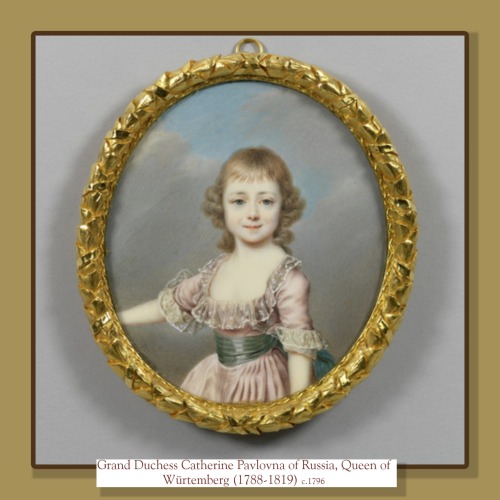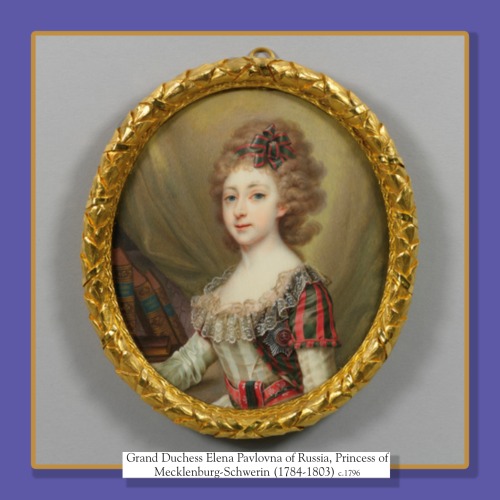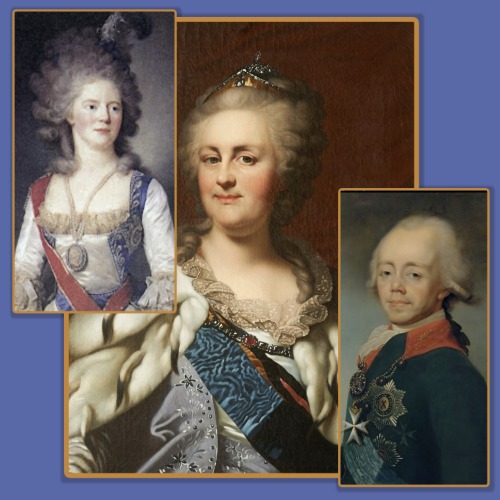#emperor paul i
The Grand Duchesses: The daughters of Tsar Paul I: Part V: Grand Duchess Anna Pavlovna (1795 - 1865)
Grand Duchess Anna Pavlovna was the eighth child and sixth daughter of Emperor Paul I. She was born after Paul’s seventh child and fifth daughter, Grand Duchess Olga Pavlovna; Olga did not live past her third year.
Anna received a good education. Because she was raised with her brothers, Michael and Nicholas, to whom she was closest in age (she would remain close to the future Nicholas I all her life), her education was broader than that of her other sisters. Like several of her sisters, Napoleon considered Anna a marital prospect. The Romanovs were intent on Napoleon not marrying into the Russian Imperial family. Anna’s mother delayed her response until Napoleon’s interest in Anna faded (and he turned it to Austrian Archduchess Marie Louise, whom he eventually married.)
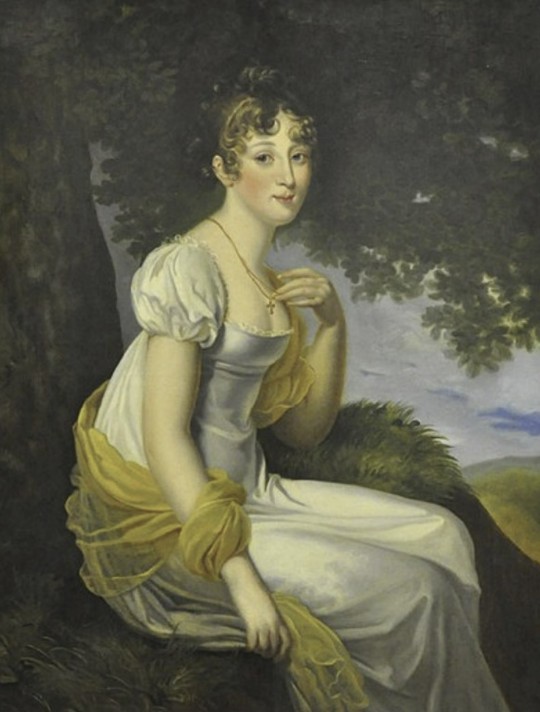
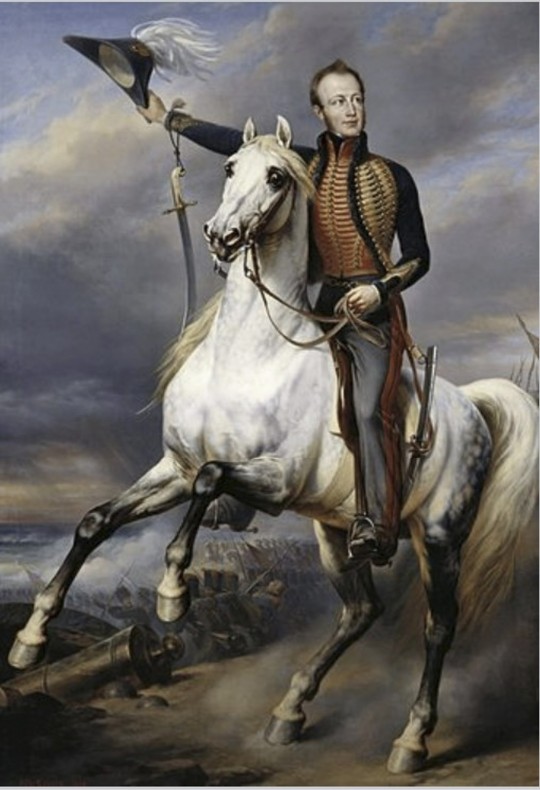
Anna was an excellent dynastic match as well as beautiful and intelligent. After considering several illustrious matrimonial prospects (the prospective Bourbon heir, the Duc de Berry, and the British Duke of Clarence), her brother Tsar Alexander I arranged her marriage to William of Orange, who would later become King William II of the Netherlands (making Anna his Queen.) She married William at the Winter Palace in Saint Petersburg. Her dowry was one million rubles.
The couple remained in Russia for one year before leaving for the Netherlands (her governess accompanied her.) Anna had problems adjusting at first, and although she came to enjoy her life in Brussels, where the nobility liked her, she always considered herself, first and foremost, a Russian Grand Duchess. She always believed she had married beneath her station. Hot-tempered and seen as elitist, Anna lamented that she could not have remained in Russia, which she visited frequently.

Her only political role as the crown princess was mediating between her husband and his father. She considered her role as a royal woman to be predominantly in charity and was very involved and successful. She founded a charity commission and a school in needlework for poor women and girls and gave financial contributions to the Anna Paulowna and Sophia schools. After the death of her mother-in-law in 1837, she took over the protection of the charity “mother foundations.” She founded a hospital in The Hague for wounded soldiers, whom she visited regularly.

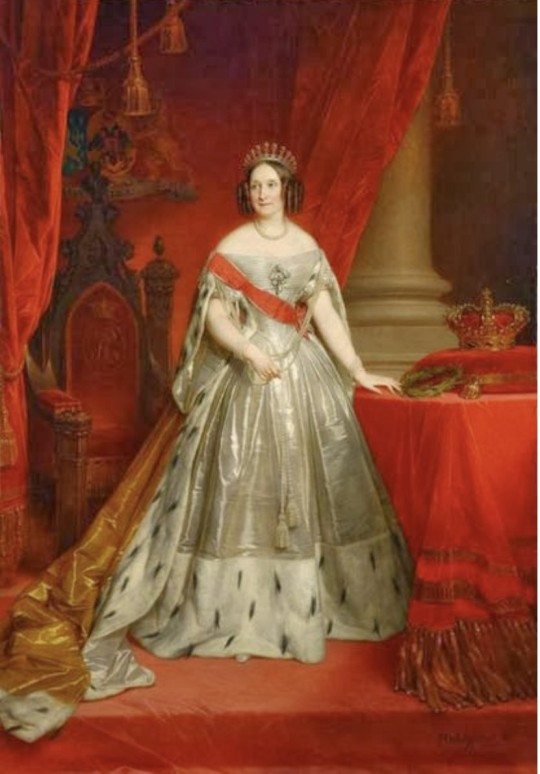
As Queen, she would never be popular and remained distant from the public; however, because she greatly valued court etiquette and ceremony, the Dutch court reportedly acquired more “royal allure” during her tenure.

Anna’s marriage was stormy; her husband was unfaithful. However, she always supported him in public. They had five children: William (on whom she focused her attention as the heir and who she unsuccessfully tried to dominate), Frederick Henry, Alexander (her favorite), and Sophia (who would eventually be the Grand Duchess of Weimar-Eisenach). She was a devoted mother. Anna eventually separated from her husband. Despite this, she continued to advise him and acted as his Queen Consort.
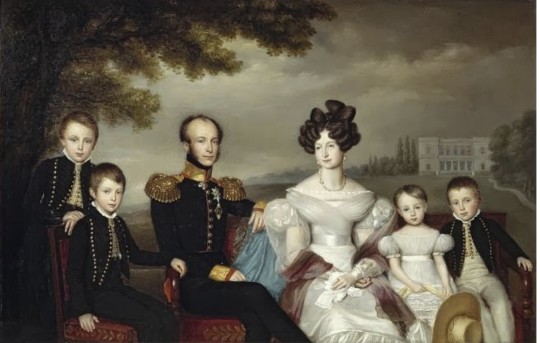


Anna Pavlovna died from a respiratory ailment. On the death of her husband in 1849, Anna was bereft and found it hard to come to terms with the loss of her official standing. She suffered financial difficulties as queen dowager and lived in quiet seclusion, constantly clashing with King William III and her daughter-in-law.


Post link
The Grand Duchesses: The daughters of Tsar Paul I: Part IV: Grand Duchess Ekaterina Pavlovna (1788- 1819)
The fourth daughter and sixth child of Emperor Paul I and Empress Maria Feodorovna was named “Ekaterina” after her paternal grandmother, Catherine the Great. Her family called her “Katya.” She was born at the Catherine Palace in Tsarkoe Selo. Like her sisters, she received a good education. She loved to read. She was said to have been beautiful and had a pleasant and vivacious personality.
Katya was close to her brother Alexander I. They remained close throughout her life. Ekaterina was Alexander’s favorite sister and one of the few persons he loved unconditionally. In his letters to her, he includes phrases like “I am yours, heart and soul, for life,” “I think that I love you more with each day that passes,” and “to love you more than I do is impossible.” Although Paul and Maria Feodorovna were initially disappointed at the birth of a fourth daughter, Ekaterina later became her mother’s favorite daughter.

At one point, Napoleon Bonaparte, who needed a young and suitably high-born bride to provide him with an heir and had decided to divorce Josephine, showed an interest in Ekaterina. The union would have been advantageous to Napoleon in more than one way. Still, its prospect horrified Ekaterina’s family, who promptly arranged for the young woman to marry a maternal cousin, Duke Georg of Oldenburg (1784-1812). Their descendants became the Russian branch of the Oldenburg.
Although the marriage had been hastily arranged, the bride and groom seemed compatible. They had two sons: Peter Georg (b. 1810 – I could not find any paintings or photographs of him - he died at age 19) and Constantine Friedrich Peter (b. 1812). The couple resided in Tver, where George had been appointed governor-general. Catherine lived a lavish court life and entertained with balls, grand dinners, and similar events in the pattern of the Russian court to create “a Small Saint Petersburg” in Tver. Like her sister Maria, she greatly enriched the cultural life of her adopted country. Unfortunately, Ekaterina’s husband died of typhoid barely three years into the marriage.
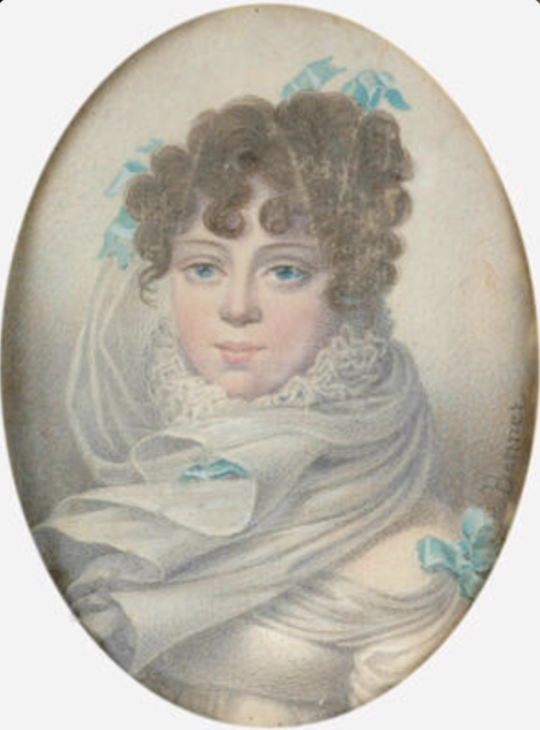
During the years immediately after the death of her husband, Ekaterina stayed with her siblings and traveled with her brother Alexander I; she traveled to England with him to meet the future George IV and accompanied him to the Congress of Vienna.
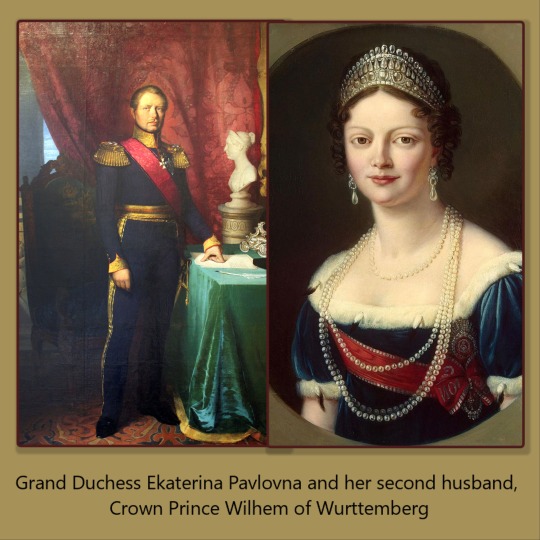
In England, Ekaterina met the Crown Prince Wilhelm of Württemberg (1781-1864). They fell in love at first sight. However, Wilhelm was already married to princess Caroline Augusta of Bavaria. Crown Prince Wilhelm and Caroline Augusta sought and got an annulment of their marriage; apparently, no love was lost between them; their marriage had been an unsuccessfully arranged one, and after its dissolution, Caroline Augusta married Emperor Franz of Austria as promptly as Wilhem married Ekaterina.
The couple’s first daughter was Princess Marie Friederike Charlotte, who was born on the same day that her grandfather died, and her father acceded to the throne of Wurttemberg; her mother thus became Queen Katharina of Württemberg. As Queen, Ekaterina supported elementary education and organized a charity foundation during the hunger of 1816. In 1818, she gave birth to another daughter, Sophie Frederike Mathilde, who would marry Ekaterina’s nephew Willem III of Orange and become Queen of the Netherlands.
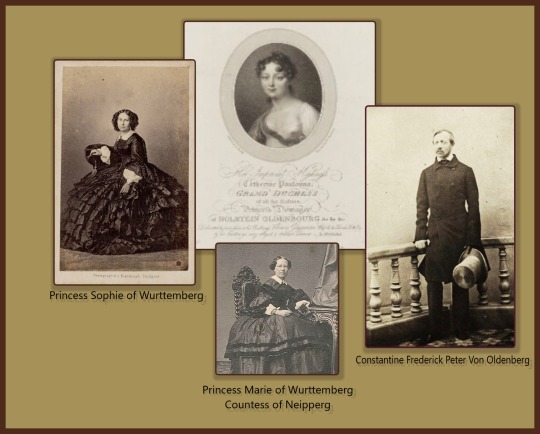

While researching this piece, I read two different versions of the causes of Ekaterina’s death. Ekaterina dies of erysipelas (not caught on time) complicated by pneumonia at Stuttgart in the first one. In the second version, Ekaterina travels to Italy, where he finds her husband with a mistress (although he loved Ekaterina, he had not given up “dalliances”). Heartbroken, Ekaterina returns home not caring to dress warmly enough and catches pneumonia that kills her at age thirty.
What is certain is that Ekaterina died six months after the birth of her youngest child, leaving four small children scattered across two families behind. Her (perhaps) unfaithful and surviving husband, built Württemberg Mausoleum in Rotenberg, Stuttgart, dedicated to her memory. He promptly married his first cousin, Pauline of Wurttemberg.
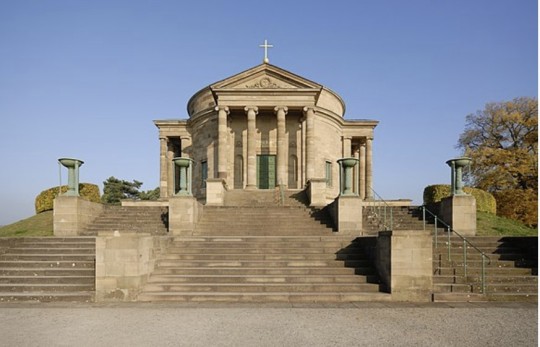
Post link
The Grand Duchesses: The daughters of Tsar Paul I: Part II: Grand Duchess Elena Pavlovna (1784 - 1803)
Grand Duchess Elena Pavlovna was Tsar Paul’s third child and second daughter. She was born in Saint Petersburg, less than a year after her sister Alexandra. The Grand Duchesses were very close and their lives seem to have run along similar paths.
Elena, like Alexandra, was born when Catherine II (the Great) was still alive. Catherine named the child after Helen of Troy; this was a reference to the little girl’s great beauty. Initially Catherine thought that Elena was a more attractive child than Alexandra (it seems that later on Alexandra became the favorite.) While Catherine was at the helm of Russia, Paul and his wife Maria Feodorovna did not even get to name their children.
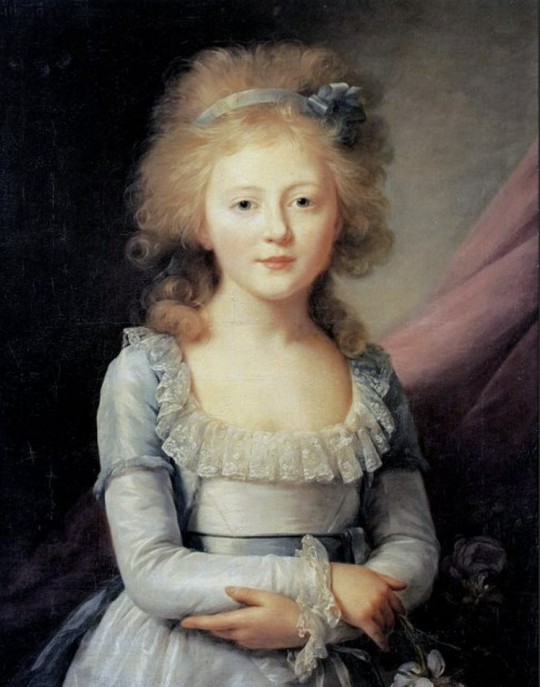

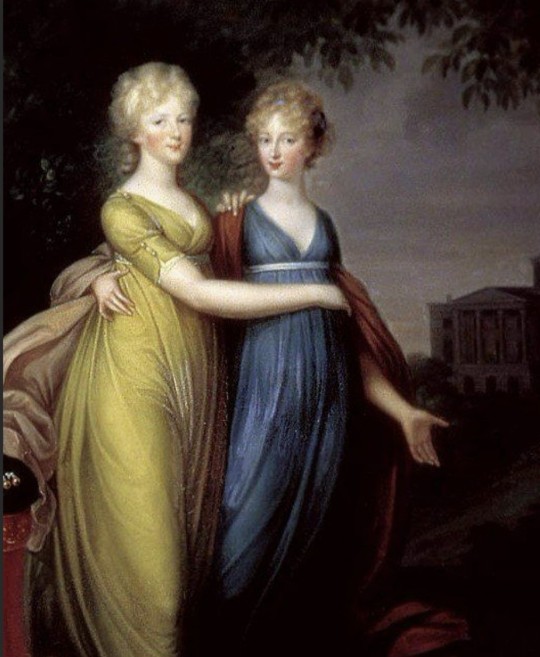
Negotiations for Elena’s marriage began when she was still a child. The bridegroom selected came from one of the small duchies which were part of the Holy Roman Empire at the time and which later would be absorbed by Germany. His name was Prince Friedrich Ludwig of Mecklenburg-Schwerin.

Hereditary Prince Friedrich Ludwig of Mecklenburg-Schewerin was described by a Russian courtier as “a handsome man but essentially rustic and ignorant, although a good person.”
The couple married at Gatchina Palace. At the time, marriages among nobles usually took place in the country of origin of the groom. Only Russian Grand Duchesses were allowed to sidestep this custom and usually married in Russia. Elena’s title after her marriage was Hereditary Duchess of Mecklenburg-Schwerin.
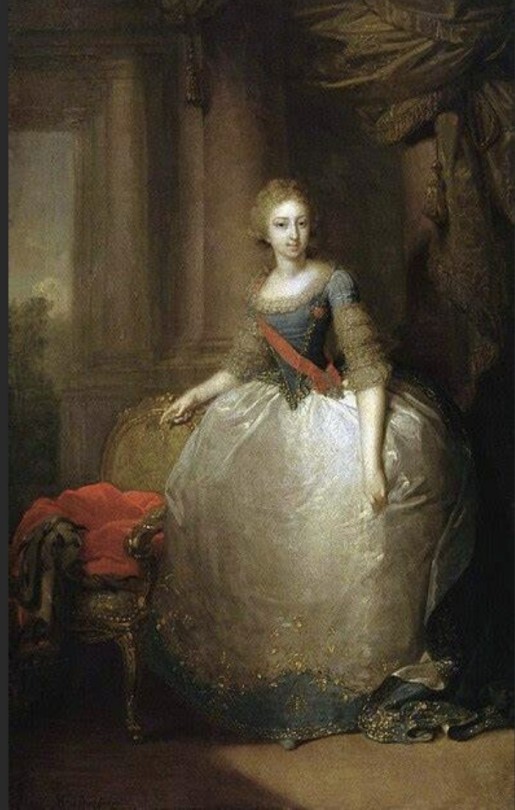
Elena had two children, Grand Duke Paul Friedrich of Mecklenburg-Schwerin and Marie Louise of Mecklenburg-Schwerin

Elena’s life was as brief as her sister’s Alexandra. The Hereditary Duchess of Mecklenburg-Schwerin married at age 15 (1799), had her first child at age 16 (1800) and her second child at age 19 (1803); she died that same year, several months after the birth of her son. Some sources mention that she died suddenly, of an unknown malady, others state that she might have had tuberculosis. She is interred in the “Helena Paulovna” Mausoleum in Ludwigslust
The Grand Duchess gave the Romanov and the Schwerin lines a number of well known descendants. I have highlighted a few below.
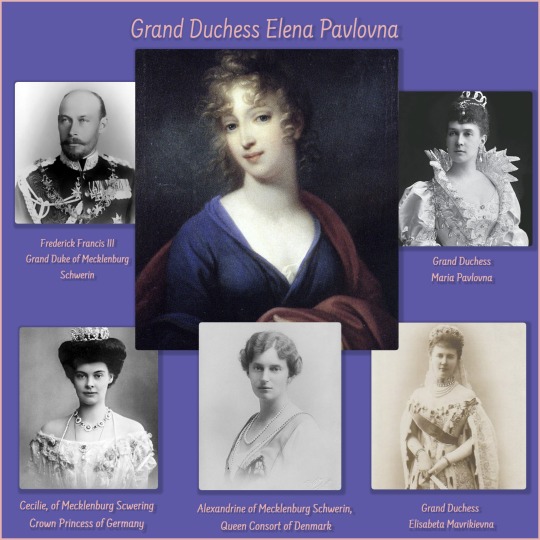
- Princess Elisabeth of Saxe-Altenburg was Elena Pavlovna´s great-granddaughter and therefore descended from Tsar Paul I. She added additional Romanov blood to her line by marrying Grand Duke Konstantin Konstantinovich and becoming Grand Duchess Elisabeta Mavrikievna.
- Princess Marie of Mecklenburg-Schwerin was Elena Pavlovna´s great-granddaughter and also descended from Tsar Paul I. She married Grand Duke Vladimir Alexandrovich and boasted of her Pauline descent by choosing the name Pavlovna at the time of her marriage.
- Maria Pavlovna´s brother was likewise Elena Pavlovna´s greatgrandson. Frederick Francis was the Hereditary Grand Duke of Mecklenburg-Schwerin when he married Grand Duchess Anastasia Mikhailovna, daughter of Grand Duke Mikhail Nikolaievich (who was Tsar Paul’s grandson). He eventually became Frederick Francis III.
- Frederick Francis III´s daughter, Cecilie of Mecklenburg-Schwerin great-granddaughter once removed of Elena Pavlovna on the paternal line and Tsar Paul’s great-grandaughter once removed on the maternal line, married into Keiser Wilhem Il’s family and became the last Crown Princess of Prussia.
- Frederick Francis III other daughter, Alexandrine of Mecklenburg-Schwerin, was also a great-granddaughter once removed of Elena Pavlovna and a great-granddaughter once removed of Tsar Paul. She became the Queen Consort of Denmark when she married Christian X. She is the great-grandmother of the current Queen of Denmark, Magrethe II, who is, therefore, also related to Elena Pavlovna!
Photographs/Illustrations: 1. Grand Duchess Elena Pavlovna; 2. The Grand Duchess’ Grandmother, Catherine the Great, and her Parents, Paul I and Maria Feodorovna; 3 and 4: Elena Pavlovna; 5. Elena and her older sister Alexandra; 6. Elena Pavlovna and her husband Hereditary Prince Friedrich Ludwig of Mecklenburg-Schwerin; 7. Elena Pavlovna; 8. Elena Pavlovna’s children, Grand Duke Paul Friedrick of Meckleburb-Schwerin and Marie Louise of Mecklenburg-Schwering; 9. Some of the descendants of Elena Pavlovna.
Post link


